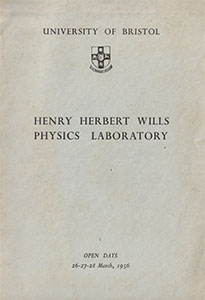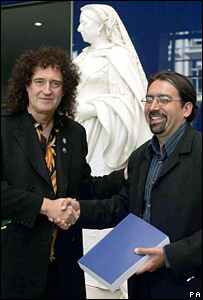Education and Universities
Early Years

Michael in Standard III (5th grade) in 1938
2nd row, 2nd from left

Crest of Sea Point High School (co-ed since 1989).
Cloth patch version, from Michael
Michael was born in Cape Town, South Africa in November, 1928. His early education occurred at the Sea Point Boys School.
University of Cape Town



University of Cape Town, South Africa, nestled right below Devil's Peak
Photo by Adrian Firth
At the University of Cape Town (UCT), Michael majored in physics and applied mathematics, receiving his bachelor's degree in 1948. He then continued at UCT, finishing a Masters degree (First Class Honours) in 1950. He stayed at UCT for another two years, as a Junior Lecturer in the department.
University of Bristol (England)

In 1952, Michael left Cape Town (by ship!) for the University of Bristol to do his PhD under the guidance of Cecil F. Powell, who had won the Nobel Prize two years prior "for his development of the photographic method of studying nuclear processes and his discoveries regarding mesons made with this method."
It was Michael's experience with this group in particle physics, cosmic rays, and scientific balloons that led him to Washington University in St. Louis in 1956, where he founded the Cosmic Ray group there, seeking to reproduce the research environment of Bristol.
He also made various life-long friends at Bristol, including Arnold Engler (a longtime physics professor at Carnegie-Mellon University in Pittsburgh, Pennsylvania) and M.G.K. ("Goku") Menon, longtime director of the Tata Institute and science advisor to the Indian government. Arnold was the person who introduced Michael to Jessica (and their resulting wonderful 62+ year marriage), while Goku was a dear friend who came to St. Louis to visit not infrequently during trips to the United States.
[In 1988 the Tata Institute held a special commemmoration of Goku's 60th birthday, including publishing two volumes: "Selected Speeches and Writings of MGK Menon" and "Selected Research Papers of MGK Menon." He sent an inscribed set of these to Michael and Jessica. For the two-page table of contents of the latter volume, four of the early papers were co-authored with Michael, as shown here.]

Bristol's HH Wills Physics Laboratory
March 1956. Michael's research
group is described on the
second-to-last page.
Michael's full set of publications is found on the CV page on this site, but the front page of the paper shown at right above is unusual. First of all it is signed by most of the authors. The authors included Michael, Menon, Powell, Giuseppe "Beppo" Occhialini (for whom the European Space Agency X-Ray satellite BeppoSAX is named), and others. Also notable is the sheer number of authors (35), 20 of whom signed this cover. This was extremely rare in these days (1955) to have this many authors and institutions, and offered a view of papers from nuclear accelerators to come, in terms of ever-growing author lists. (In fact, it has been called the first paper with the first page showing nothing but authors (C. Olivotto, "The Mediterranean flights and the G-Stack collaboration (1952-55): A first example of European collaboration in particle physics", Sept 2006.))
In March 1956, Bristol's H.H. Wills Physics Laboratory held its (annual?) open house "open days", for which it produced a brochure describing all the research endeavors. Michael's research group's work on mesons is described on page 16.
This is probably as good a place as any to mention the idea of a "physics genealogy tree". In a small number of fields (chemistry, plus piano and violin pedagogy), people have figured out who studied with whom and thus who is a "grand-student" or "great-grand-student" of someone major in the field.
For Michael, his Physics tree shows that having studied with Powell, that makes him a "grand-student" of Ernest Rutherford, a "great-grand-student" of J.J. Thompson, and one connects to Kirchoff, Helmholtz, and Maxwell if one goes back one more generation! [static view of physics tree, in case above web site is unresponsive]

Physics crowd, 1955 Michael is row 2, far right; Arnold Engler is row 2, 2nd from left (crouching), Cecil Powell is back row center with jacket.
 Bristol lab group, 1953
(Michael at far left)
Bristol lab group, 1953
(Michael at far left)

Michael, MGK Menon, and Cecil Powell at 1953 ICRC, Bagnères-de-Bigorre, France (this is a detail of the full conference photo.)

Michael and close friend MGK Menon in St. Louis, 1984 (Photo by David Friedlander)

Arnold Engler with Jessica & Michael, August 1998 in Pittburgh
Imperial College, London


Michael was awarded a Guggenheim Fellowship in 1962 and chose to spend it as a researcher at Imperial College London.
Years later, he returned there for a sabattical in the fall of 1971. A significant chunk of his first book, The Conduct of Science, published in 1972, was written during this time in England.
An interesting aside

Brian May at Tenerife Observatory, 1971

Brian May hands thesis to Paul Nandra,
August 2007
When Michael was at Imperial College in 1971, he knew (although not well) a graduate student who was studying zodiacal dust in the Astrophysics Department. This young man soon dropped out of school two-plus years later because he was the guitarist in a band that was becoming popular. This turned out to be Brian May, the lead guitarist of Queen! (Michael was never a rock-and-roll fan, so he knew basically nothing about the band!)
The other interesting connection here is that May returned to Imperial College decades later and completed his PhD in August 2007. There was a widely distributed photo of May handing his thesis to Astrophysics Department chairman Paul Nandra, whom I (David) knew from Paul's time as a postdoctoral fellow (staff scientist) at the NASA/Goddard Space Flight Center in the early 2000s.
(Nice article from Astronomy Magazine (September 2012) about May's interest and background in astronomy. This article mentions May's unusual performance of God Save the Queen from the roof of Buckingham Palace in June 2002 for the Queen's Golden Jubilee.)



